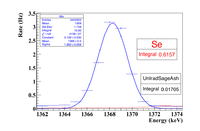Difference between revisions of "PAA Sage"
| Line 10: | Line 10: | ||
| − | [[File:SageBrushMg-vs-VolOil_Powell.pdf]] | + | <ref name="Krous1962">[[File:SageBrushMg-vs-VolOil_Powell.pdf]] </ref> |
| + | |||
| + | <reference/>[[File:SageBrushMg-vs-VolOil_Powell.pdf]] | ||
=Preliminary results= | =Preliminary results= | ||
Revision as of 19:49, 17 August 2017
PAA_Research PAA on Sage Brush
Motivation
The volatile oil content of sage brush is known to be a strong indicator of both the flammability of sage brush as well as its forage value for open range livestock. The volatile oils in sage brush leaves impede the growth of rumen micro-organisms thereby decreasing an animal's appetite. The amount of Magnesium in sage brush leaves has been shown to be strongly correlated with the volatile oil content of sage brush. We studied the potential to use Photon Activation Analysis at the Idaho Accelerator Center as a means to measure the Magnesium content of sage brush. The figure below illustrates our ability to identify the presence of Magnesium in sage brush leaves. With further work, this method has the potential to provide ranchers and the fire prevention services with a means of monitoring the forage value and fire risk of Idaho's sage brush population.
<ref name="Krous1962">File:SageBrushMg-vs-VolOil Powell.pdf </ref>
<reference/>File:SageBrushMg-vs-VolOil Powell.pdf
